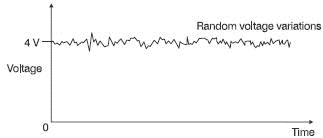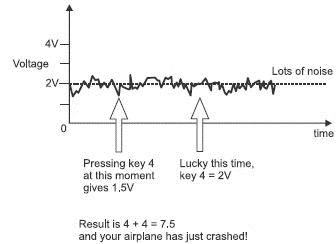Книга: Introduction to Microprocessors and Microcontrollers
The noise problem
The noise problem
If the input of a microprocessor is held at a constant voltage, say 4 V, this would appear as in Figure 2.1.

Figure 2.1 A constant voltage
If we try to do this in practice, then careful measurements would show that the voltage is not of constant value but is continuously wandering above and below the mean level. These random fluctuations are called electrical noise and degrade the performance of every electronic circuit. We can take steps to reduce the effects but preventing it altogether is, so far, totally impossible. We can see the effect by disconnecting the antenna of our television. The noise causes random speckles on the screen which we call snow. The same effect causes an audible hiss from the loudspeaker. The effect of noise is shown in Figure 2.2.

Figure 2.2 A ‘noisy’ voltage
Most microprocessors use a power supply of 5 V or 3.3 V. To keep the arithmetic easy, we will assume a 5 V system.
If we are going to persuade the microprocessor to count from 0 to 9, as we do, using voltages available on a 5 V supply would give 0.5 V per digit:
0 = 0 V
1 = 0.5 V
2 = 1 V
3 = 1.5 V
4 = 2 V
5 = 2.5 V
6 = 3 V
7 = 3.5 V
8 = 4 V
9 = 4.5 V
If we were to instruct our microprocessor to perform the task 4 + 4 = 8, by pressing the ‘4’ key we could generate a 2 V signal which is then remembered by the microprocessor. The + key would tell it to add and pressing the ‘4’ key again would then generate another 2 V signal.
So, inside the microprocessor we would see it add the 2 V and then another 2 V and, hence, get a total of 4 V. The microprocessor could then use the list shown to convert the total voltage to the required numerical result of 8. This simple addition is shown in Figure 2.3.

Figure 2.3 It works! 4 + 4 does equal 8
This seemed to work nicely – but we ignored the effect of noise. Figure 2.4 shows what could happen. The exact voltage memorized by the microprocessor would be a matter of chance. The first time we pressed key 4, the voltage just happened to be at 1.5 V but the second time we were luckier and the voltage was at the correct value of 2 V.

Figure 2.4 Noise can cause problems
Inside the microprocessor:
1.5 V + 2 V = 3.5 V
and using the table, the 3.5 V is then converted to the number 7. So our microprocessor reckons that 4 + 4 = 7.5!
Since the noise is random, it is possible, of course, to get a final result that is too low, too high or even correct.
- The noise problem
- A complete cure for electrical noise
- Thermal noise
- Partition noise
- How much noise can we put up with?
- Using just two digits
- How do we count?
- The basic basis of bases
- Counting with only two figures
- Confusion and the cure
- Converting denary to binary
- Converting binary to denary
- Bits, bytes and other things
- Quiz time 2
- The only problem with binary
- How much noise can we put up with?
- The basic basis of bases
- Thermal noise
- Bits, bytes and other things
- 4.4.4 The Dispatcher
- About the author
- Chapter 7. The state machine
- Appendix B. Common problems and questions
- Appendix E. Other resources and links
- Example NAT machine in theory
- Parameter problem




